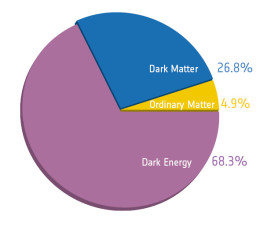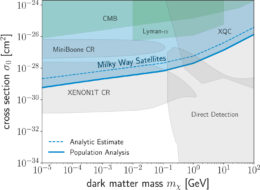Though dark matter appears to be common in the universe, there’s still a lot we don’t know about it. A new study has now shed some light on this mysterious topic using faint satellite galaxies around the Milky Way.
Prolific Yet Unseen

The relative amounts of the different constituents of the universe. Dark matter makes up roughly 27%. [ESA/Planck]
This challenge means that we’re still working to understand the nature of this unseen substance. Is dark matter made up of primordial black holes? An as-yet undiscovered subatomic particle? Or something else entirely?

Strong gravitational lensing like that observed in this image of Abell 1689 provides evidence for dark matter, but we still don’t understand its nature. [NASA/N. Benitez/T. Broadhurst/H. Ford/M. Clampin/G. Hartig/G. Illingworth/the ACS Science Team/ESA]
The Hunt for the Right Model
Based on our observations and models of our universe, the standard picture of dark matter is the ΛCDM model, in which dark matter is described as cold (it moves slowly, forming structures only gradually) and collisionless (it doesn’t scatter off of ordinary matter, instead effectively passing through it).
The cold, collisionless dark-matter model has held up to a number of tests, and it neatly explains the large-scale structure of our universe. But some challenges to the model exist, and astronomers are still considering a number of alternative pictures.
In a new study led by Ethan Nadler (Kavli Institute for Particle Astrophysics and Cosmology, Stanford University), a team of scientists has now tested alternative theories by asking whether dark matter might not be collisionless, but instead interacts with ordinary matter.
Suppressing Structure
Nadler and collaborators point out that alternative models that treat dark matter as a collisional fluid come with a catch: in this picture, as dark matter scatters off of particles in the early universe, heat and momentum are transferred. This transfer smooths out perturbations in the distribution of matter, suppressing the very glitches that would later grow to become small-scale structure in the universe today.
In effect, the more that dark matter collides with baryons, the less small-scale structure there should be today — limiting the number of low-mass dark-matter halos in our galactic neighborhood and constraining how many small, faint galaxies reside within them.

Upper limits on the velocity-independent dark-matter–proton scattering cross section as a function of dark-matter particle mass. The different shaded regions show values excluded by various observations. The blue shaded exclusion region is the new constraint placed by observations of Milky Way satellites in the current study. Click to enlarge. [Nadler et al. 2019]
Collisions Limited
So what do observations tell us? By combining the observed population of classical and Sloan Digital Sky Survey (SDSS)-discovered Milky-Way satellite galaxies with some clever probabilistic modeling of the population, Nadler and collaborators were able to place strict limits on the scattering cross sections for different-sized dark-matter particles, thereby constraining just how “collisional” dark matter can be.
The authors’ work continues to support the standard, collisionless picture of dark matter — but there’s plenty of room for deeper constraints. As data arrives from upcoming imaging programs like the Large Synoptic Survey Telescope (LSST), we’re sure to learn more about the small-scale structure of our surroundings and what it means for the nature of mysterious dark matter.
Citation
“Constraints on Dark Matter Microphysics from the Milky Way Satellite Population,” Ethan O. Nadler et al 2019 ApJL 878 L32. doi:10.3847/2041-8213/ab1eb2

2 Comments
Pingback: Daily Log (2019-09-12) - Study Astrophysics
Pingback: Philosophy Of Science And Cosmology – Panacea Philosophica